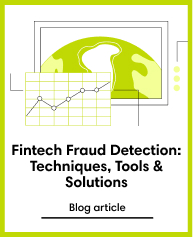Fraud
Nov 7, 2025
What You Need to Know About Fraud Detection Analytics in Banking
Subscribe to our newsletter
Banking fraud poses an increasing threat worldwide, with financial institutions facing escalating losses and sophisticated attacks. In 2025, over 60% of banks reported a surge in fraud attempts, driven by organised crime and increasingly complex schemes.
Traditional prevention methods cannot keep pace with such evolving threats. Consequently, analytics-driven, data-centric approaches, particularly those leveraging machine learning (ML), have become increasingly essential.
These approaches enable faster detection of fraudulent patterns and accurate prevention, safeguarding banks and their customers. Effective fraud prevention is no longer optional but necessary for maintaining trust and financial stability.
What is Fraud Detection Analytics in Banking?
Fraud detection analytics in banking refers to the use of advanced data analysis techniques to identify suspicious or potentially fraudulent activities. It works by sifting through vast amounts of transaction data to detect unusual patterns or anomalies that indicate fraud.
Utilising ML models, it assigns risk scores to transactions in real time. This allows banks to make informed decisions about whether to approve, block, or escalate transactions for further verification.
This approach is critical in modern banking systems, helping protect financial assets and maintain customer trust while minimising false positives and operational friction.
Importance of Fraud Detection Analytics
Fraud detection analytics offers significant benefits to banks. It enhances security by identifying and preventing fraudulent transactions in real time.
It supports regulatory compliance by automating suspicious activity reporting, helping banks meet legal requirements efficiently. This proactive approach reduces financial risks and operational costs by minimising false positives and focusing resources on genuine threats.
Moreover, it strengthens customer trust by safeguarding assets and ensuring secure banking experiences. Ultimately, fraud detection analytics mitigate risk, protect the bank's reputation, and foster long-term client confidence, which are vital in today’s increasingly digital banking environment.
Common Types of Fraud in Banking
Fraud in banking takes many forms, evolving constantly to exploit system vulnerabilities. The following are key types of fraud that pose significant risks to banks and customers alike:
- Account Takeover (ATO)
This occurs when criminals use stolen credentials to gain unauthorised access to bank accounts. They then conduct fraudulent transactions, such as transferring funds or making purchases, often resulting in significant financial losses to victims.
The rapid rise of artificial intelligence (AI), along with AI-powered social engineering and voice cloning, has increased the frequency and sophistication of these attacks, making detection extremely challenging.
- Identity Fraud
Fraudsters obtain and misuse personal information to open new accounts or access existing ones. They may create synthetic identities by combining real and fake data, which facilitates loan fraud or illicit transactions without detection.
As digital onboarding expands, identity fraud has surged. It exploits gaps in verification processes and harms financial institutions and consumers.
- Loyalty Points Abuse
Experienced fraudsters exploit reward programmes by illegally redeeming loyalty points. This abuse undermines the value of reward schemes, leading to financial losses for banks.
Increasingly, fraudsters are using automated scripts and bots to manipulate loyalty systems, resulting in widespread point theft.
- Cashback Abuse
Fraud involves manipulating cashback offers through fake or multiple transactions to obtain cashback rewards illicitly. This affects promotional budgets and increases fraud-related costs.
Growing e-commerce and digital payment volumes have made cashback abuse prevalent and a costly issue for financial providers.
- Referral Fraud
Criminals exploit referral programmes by creating false accounts or manipulating referrals to gain unauthorised rewards or bonuses, undermining marketing efforts.
As banks expand incentive campaigns, referral fraud has escalated, often involving organised groups coordinating large-scale abuse.
- AI Related Fraud
Recent advances have led to sophisticated fraud using deepfakes and automated bots (BOTs). These technologies impersonate customers or staff, making it challenging to detect and combat fraud.
Challenges in Fraud Detection
Fraud detection in banking faces several significant challenges. The sheer volume of daily transactions requires highly scalable and efficient systems capable of screening millions of activities in real-time.
Fraud tactics continuously evolve, with criminals using sophisticated methods that outpace traditional detection rules. Regulatory compliance is another hurdle, as banks must navigate complex and ever-changing laws while maintaining robust fraud controls.
Balancing security measures with a seamless customer experience is crucial, as overly strict protocols can lead to user frustration and attrition. These challenges necessitate advanced, adaptable analytics solutions to effectively mitigate fraud risks without compromising client satisfaction.
Advanced Techniques in Fraud Detection
Modern banking employs several sophisticated methods to detect and prevent fraud more effectively. One of those is predictive analytics, which uses historical and real-time data to forecast potential fraud risks.
AI and ML analyse transaction patterns, learning from new data to identify suspicious activities with increasing accuracy. Biometric technologies, such as fingerprint or facial recognition, enhance identity verification to prevent unauthorised access.
Real-time monitoring continuously scans transactions, enabling immediate response to potential fraud. Together, these advanced techniques form a robust defence, allowing banks to stay ahead of evolving threats and minimise financial losses.
Use Cases of Fraud Analytics in Banking
Fraud analytics has a wide range of practical applications that enhance the security and compliance of banking systems. Real-time transaction monitoring scrutinises every payment for unusual patterns, enabling immediate fraud detection and prevention.
Account takeover (ATO) detection identifies unauthorised access by analysing behavioural data such as login patterns and device recognition. Anti-money laundering (AML) compliance is strengthened by detecting suspicious fund flows and automating regulatory reporting.
Payment security improvements include identifying fraudulent card usage and stopping unauthorised wire transfers before completion. These use cases illustrate the crucial role of fraud analytics in protecting financial institutions and their customers.
Top Tools for Fraud Analytics in Banking
Leading tools in fraud analytics leverage advanced technologies to provide robust detection and prevention capabilities.
- Feedzai is a prominent AI-driven platform for real-time transaction monitoring and risk scoring.
- FICO Falcon Fraud Manager uses predictive analytics and neural networks for cross-channel fraud protection.
- NICE Actimize provides comprehensive AML compliance and fraud detection solutions with behavioural biometrics.
- ComplyAdvantage specialises in AI-powered AML monitoring and risk management.
- BioCatch leverages behavioural biometrics for identity verification.
- APIs like LexisNexis ThreatMetrix offer device fingerprinting and global risk intelligence.
Together, these tools enable banks to enhance security, automate compliance, and effectively reduce fraud-related losses.
Implementing Fraud Analytics in Banking
Implementing fraud analytics begins with integrating diverse data sources, including transaction history, customer profiles, and behavioural data, to create a comprehensive dataset.
AI modelling and ML algorithms are then developed to identify patterns and predict fraudulent activities. Continuous monitoring systems analyse real-time transactions, triggering alerts for suspicious behaviour.
Ensuring compliance involves automating regulatory reporting and aligning detection processes with legal standards. Finally, ongoing optimisation is crucial, with models regularly updated to adapt to emerging fraud tactics. This helps reduce false positives and ensures a balance between security and customer experience.
Conclusion
Fraud analytics in banking is indispensable for protecting financial institutions and their customers against increasingly sophisticated fraudulent activities.
Banks can detect and prevent fraud effectively by leveraging advanced data analysis, ML, and real-time monitoring while maintaining regulatory compliance.
This reduces financial loss and strengthens customer trust and operational efficiency. As fraud tactics continue to evolve, the future of banking security lies in the continuous enhancement and integration of analytics-driven fraud detection.
Embracing these innovations will be crucial for banks to safeguard assets and foster long-term resilience in an ever-changing digital landscape.
FAQs
What is fraud detection analytics in banking?
Fraud detection analytics uses data analysis and ML to identify suspicious transactions and predict fraudulent behaviour. It helps banks prevent losses by flagging real-time anomalies, improving security without hindering genuine customer activity.
How do banks prevent account takeover using fraud analytics?
Banks use fraud analytics to monitor login behaviours, device usage, and transaction patterns. ML models detect unusual access attempts or changes, triggering alerts or additional authentication steps to block unauthorised account takeovers and protect customer funds.
Which technologies are most effective for fraud detection in banking?
Effective technologies include ML, AI, behavioural biometrics, device fingerprinting, and real-time transaction monitoring. These tools analyse patterns, recognise anomalies, and enable automated responses to prevent diverse types of banking fraud effectively.
How do AI and ML improve fraud prevention?
AI and ML enhance fraud prevention by analysing large volumes of data quickly, learning evolving fraud patterns, and continuously adapting detection models. This enables real-time risk scoring, reducing false positives and facilitating smoother customer experiences with enhanced security.
What are the key challenges in implementing fraud analytics in banking?
Challenges include managing large transaction volumes, evolving fraud tactics, ensuring regulatory compliance, and integrating diverse data sources. Another key challenge is striking a balance between effective fraud detection and minimal impact on customer experience and operational costs.





